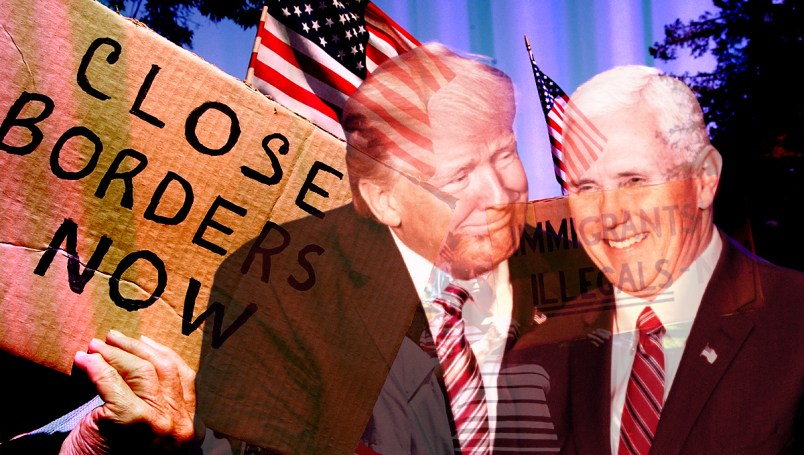This piece is part of TPM Cafe, TPM’s home for opinion and news analysis.
President Donald Trump’s base simultaneously cares deeply about defending Christianity and restraining immigration.
It’s a stance we’ve come to expect, but there’s an irony to this. At a moment when more and more Americans are unaffiliated with religion, immigration is providing a counterbalance.
In fact, nothing would do more to strengthen Christianity than embracing undocumented immigrants. Most undocumented immigrants come from Latin America, so 83 percent are Christian. If they were all expelled, the United States would lose 9 million Christians. By contrast, legal immigrants tend to come from countries like India, Pakistan and China, with majority non-Christian populations.
Beyond that, it is well known that for the past few decades Latino immigration has energized, and in some ways saved, the Catholic Church in the United States. About 40 percent of American Catholics are Hispanic, and they’re more likely to say religion is “very important” in their lives than white Catholics.
What’s less acknowledged is that Latinos have also bolstered evangelical communities. Some 16 million evangelicals are Hispanic, and about 15 percent of all immigrants are evangelical.
Beyond the specifics, I’d argue that immigration has been a key factor in strengthening religious freedom in the U.S. New immigrants are more likely to be religious and to say it’s important in their lives than the general population.
Going back through history, immigration has repeatedly injected energy and piety to the American religious landscape.
From our country’s founding, diversity has been important to ensuring religious liberty. When James Madison guided the creation of the First Amendment, he believed that a “multiplicity of sects” would be more important than “parchment barriers.” Having a variety of religions or Christian denominations would prevent one religion from dominating the others, and therefore help create a fluid religious marketing place that would encourage religious vibrancy.
In the United States, religious diversity has flowered in three different ways: homegrown religious entrepreneurship (American-created religions like Mormonism, Seventh Day Adventism or Jehovah’s Witnesses); denominational splintering, and finally, immigration.
In the case of immigration, the positive effects may not be evident right way. Throughout American history, the arrival of new immigrants practicing minority religions has often prompted backlash, as happened throughout the 19th century with Irish Catholics. In 1835, Samuel Morse, who would later invent the telegraph, warned that foreign countries were sending us “their criminals” because America hadn’t erected the right “walls.” He also complained that he and his allies were being unfairly attacked by a liberal media that was “on the side of your enemies.”
But the Catholic influx not only enriched American life in countless ways, it strengthened religious freedom by making it impossible for Protestant majorities to impose their faith approach on others. For instance, until Catholics objected, public schools in the 19th century had insisted on teaching the Protestant translation of the Bible to children. Catholics demanded that if the Bible were to be taught, their translation had to be included too. This established the idea that religion can only live in public places if other religions are invited to participate too.
At another point in the 19th century, Protestants became worried about a different group of immigrants flooding across the border – Mormons coming from Canada. Horrible persecution ensued. In 1838, the governor of Missouri proclaimed that “the Mormons must be treated as enemies, and must be exterminated or driven from the State if necessary for the public peace.” Over time, the growth and persistence of the Mormons forced Americans to expand their definition of religious freedom.
In the 1920s, efforts to restrict immigration were driven in part by the fear that too many Jews had arrived from Eastern Europe. By World War II, though, America decided that Jews needed to be incorporated as full partners in the pluralistic model and that their presence demonstrated something inspiring about the nation. Presidents Roosevelt, Truman and Eisenhower cast religious freedom and pluralism as a sign of America’s moral superiority over fascism and communism.
Eisenhower became the first president to use the term “Judeo-Christian.” He explained, “Our form of government has no sense unless it is founded in a deeply felt religious faith, and I don’t care what it is. With us of course it is the Judeo-Christian concept, but it must be a religion that all men are created equal.”
In 1993, Congress proposed the Religious Freedom Restoration Act, which more deeply enshrined key modern principles of religious liberty. Tellingly, the bill’s main sponsors were religious minorities with immigrant ancestors: Charles Schumer and Stephen Solarz, both Jewish, in the House, and Ted Kennedy, an Irish Catholic and Orrin Hatch, a Mormon.
Over America’s history, immigration has helped fuel a virtuous cycle for religious freedom. Immigration has brought energy to religious institutions – and has prevented just one denomination from becoming powerful enough to squelch liberty.
Madison didn’t argue explicitly for immigration as a lubricant for religious freedom’s mechanisms. But he did argue for variety. It turns out that immigration has been a major reason this system has worked so well.
Steven Waldman is the author of Sacred Liberty: America’s Long, Bloody and Ongoing Fight for Religious Freedom, and co-founder of Report for America.






